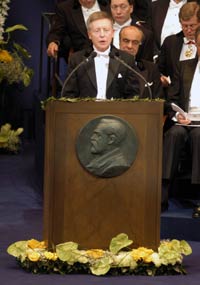Award ceremony speech
Presentation Speech by Professor Per Carlson of the Royal Swedish Academy of Sciences, December 10, 2002.
Translation of the Swedish text.

Copyright © Nobel Media AB 2002
Photo: Hans Mehlin
Your Majesties, Your Royal Highnesses, Ladies and Gentlemen,
Does the slow gravitational contraction of the sun produce the sunlight which makes life on our planet possible? This was a prominent question in scientific circles during the mid-1800s. Not until 1920 was it suggested that the sun’s energy comes from nuclear reactions in its core, where high pressure forces hydrogen to be converted into helium and large quantities of energy are released.
The most common particle in the universe, the neutrino, is created in huge quantities during these reactions. These remarkable particles pass unaffected through the enormous mass of the sun and reach us on the earth. Each second, 60 billion neutrinos pass through each square centimeter of the earth’s surface! Ray Davis and later Masatoshi Koshiba took on the challenge of catching solar neutrinos. However, the neutrinos are very difficult to detect because they only interact very weakly with matter. Only one out of every 1,000 billion neutrinos from the sun is stopped when they pass through the earth.
Raymond Davis devised an ingenious detection method. He caught neutrinos deep down in a gold mine in South Dakota, where the background disturbances were low. In a huge tank filled with a fluid rich in chlorine, a few neutrinos could interact with the chlorine and produce argon. Ten times a year, he flushed out the argon atoms and counted them. During a quarter of a century, he trapped about 2,000 neutrinos – a catch more valuable than gold!
Masatoshi Koshiba also caught his neutrinos in a deep mine at Kamioka, west of Tokyo. In a huge water tank, light flashes were detected from the rare neutrino interactions in the water, using the sensitive detectors developed by Koshiba.
The sun will end its life in 5 billion years as a white dwarf. Heavier stars end their lives with a supernova explosion. When the nuclear reactions cease, gravity contracts the star. A neutron star or a black hole is formed and in a few seconds an enormous amount of energy, more than 100 times the total energy release of the sun during its life of 10 billion years, is released. Supernovae are common in the universe, but rare in our neighborhood. In a nearby galaxy 170,000 light years away, a billion times farther away than our sun, a supernova became visible from the earth on 23 February 1987. In the space of a few seconds, the gravitational energy was converted to neutrinos that were emitted in a gigantic burst. Ten million billion (10,000,000,000,000,000) of them reached Koshiba’s water tank and 12 were detected, confirming theories of supernovae.
Wilhelm Conrad Röntgen received the first Nobel Prize in Physics in 1901 for the discovery of X-rays. In contrast to neutrinos, cosmic X-rays do not even penetrate the earth’s atmosphere. At the end of the 1940s, scientists discovered that X-rays were emitted from the surface of the sun. In Riccardo Giacconi’s 6-minute long, pioneering 1962 rocket experiment, the aim was to search for X-rays from the sun being reflected by the moon. Instead, the experiment discovered a large flow of cosmic X-rays, including the first X-ray source outside our solar system. Giacconi further developed the X-ray technique and constructed X-ray telescopes. Many X-ray satellite missions followed.
Giacconi’s achievements in X-ray astronomy have dramatically changed our view of the universe. The universe not only contains stars and star constellations in slow development but also hosts rapidly evolving compact objects which release enormous amounts of energy. Of particular interest is the possibility of indirectly detecting black holes.
Professors Davis and Koshiba, Professor Giacconi,
your groundbreaking research has opened new windows on the universe. You have conducted your experiments underground in deep mines to reduce background or at high altitudes using rockets and satellites to escape from the earth’s atmosphere. We are now all together at sea level and on behalf of the Royal Swedish Academy of Science I wish to congratulate you for your outstanding work and I now ask you to step forward to receive the Nobel Prize in Physics from the hands of His Majesty the King.
Nobel Prizes and laureates
Six prizes were awarded for achievements that have conferred the greatest benefit to humankind. The 14 laureates' work and discoveries range from quantum tunnelling to promoting democratic rights.
See them all presented here.
